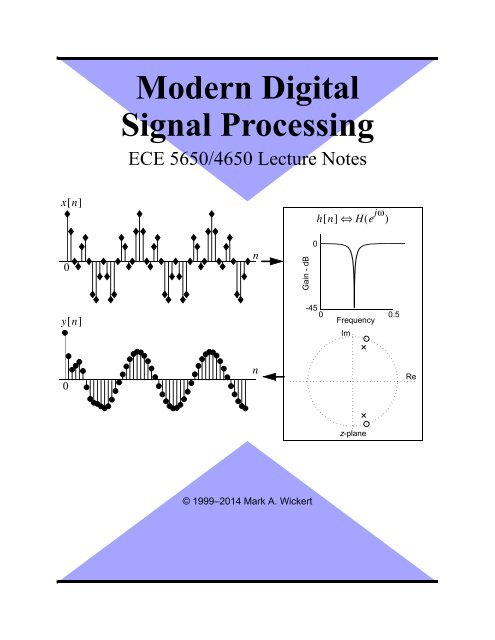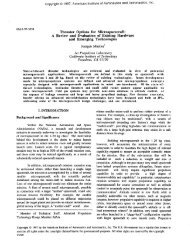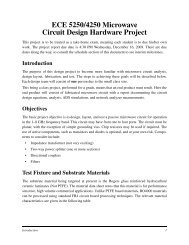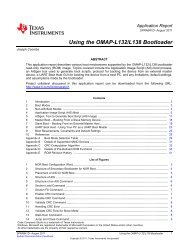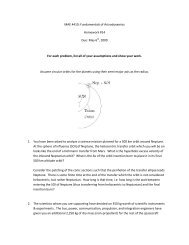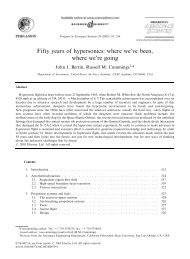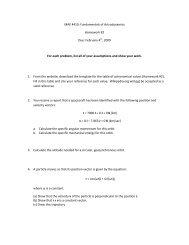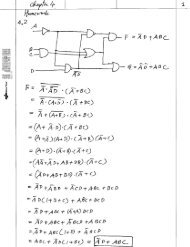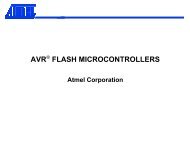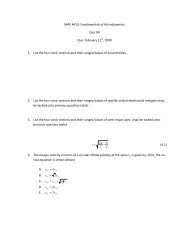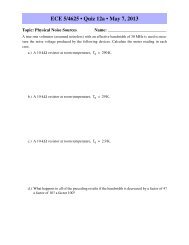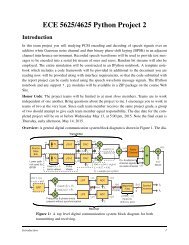Modern Digital Signal Processing - World Colleges Information
Modern Digital Signal Processing - World Colleges Information
Modern Digital Signal Processing - World Colleges Information
You also want an ePaper? Increase the reach of your titles
YUMPU automatically turns print PDFs into web optimized ePapers that Google loves.
xn [ ]nhn [ ] ⇔ He ( jω )yn [ ]nz
Chapter1Course Introduction/OverviewContents1.1 Introduction to <strong>Modern</strong> <strong>Digital</strong> <strong>Signal</strong> <strong>Processing</strong> . . 1-31.2 Contemporary DSP . . . . . . . . . . . . . . . . . . . 1-41.2.1 The Technology . . . . . . . . . . . . . . . . . 1-41.2.2 Key Applications Areas . . . . . . . . . . . . . 1-51.3 Course Perspective in Comm/DSP Area ECE . . . . . 1-71.4 What is this course about? . . . . . . . . . . . . . . . 1-81.5 Software Analysis/Simulation Tools . . . . . . . . . . 1-91.6 The Computer Projects . . . . . . . . . . . . . . . . . 1-101.7 Course Syllabus . . . . . . . . . . . . . . . . . . . . . 1-111.8 Instructor Policies . . . . . . . . . . . . . . . . . . . . 1-121-1
CHAPTER 1. COURSE INTRODUCTION/OVERVIEW.1-2 ECE 5650/4650 <strong>Modern</strong> DSP
1.1. INTRODUCTION TO MODERN DIGITAL SIGNAL PROCESSING1.1 Introduction to <strong>Modern</strong> <strong>Digital</strong> <strong>Signal</strong><strong>Processing</strong>✏ Contemporary DSP– Theory– Technology– Applications✏ Course perspective– Expected background– Where to go from here✏ What is this course about?✏ The role of computer analysis/simulation tools in and outsidethis course✏ The computer simulation project✏ Instructor policiesECE 5650/4650 <strong>Modern</strong> DSP 1-3
CHAPTER 1. COURSE INTRODUCTION/OVERVIEW1.2 Contemporary DSP✏ The theoretical foundation for <strong>Modern</strong> signal processing gotit’s start back in the late 1960s and early 1970s✏ Two key texts which started this era are <strong>Digital</strong> <strong>Signal</strong> <strong>Processing</strong>by Oppenheim and Schafer and Theory and Application of<strong>Digital</strong> <strong>Signal</strong> <strong>Processing</strong> by Rabiner and Gold, both publishedin 1975✏ The Oppenheim and Schafer Discrete-Time <strong>Signal</strong> <strong>Processing</strong>text (1989, 1999, 2010) is now in its third edition✏ A good source of recent theoretical developments is the IEEEJournal on <strong>Signal</strong> <strong>Processing</strong> (formerly Acoustics Speech and<strong>Signal</strong> <strong>Processing</strong>) and the annual Proceedings of the InternationalConference on Acoustics Speech and <strong>Signal</strong> <strong>Processing</strong>(ICASSP)✏ Other applied digital signal processing conferences exist andare usually associated with trade shows1.2.1 The Technology✏ DSP chips/architectures– Integer/Fixed point implementations– Floating point implementations– FPGA based implementations✏ DSP software and tools1-4 ECE 5650/4650 <strong>Modern</strong> DSP
1.2. CONTEMPORARY DSP1.2.2 Key Applications Areas✏ Computers/Internet– Broadband access– Voice over IP– MP3 and related high quality audio formats– Multimedia in general: data, voice, music, & video✏ Wireless Communications– Mobile communications (over 200 million phones/yr overthe world)– High-speed modems and xDSL– Real-time data compression for voice and video– Wireless and telecommunication infrastructure✏ Industrial– Real-time processing of industrial and medical signals– PC with DSP for virtual instruments for test and analysis✏ <strong>Digital</strong> Control Systems✏ Audio– DSP vs microprocessors and microcontrollers– MP3 players– Home audio and theatre systems– Noise cancelling, e.g., quieting a car interior using adaptivenoise cancellation or headphonesECE 5650/4650 <strong>Modern</strong> DSP 1-5
CHAPTER 1. COURSE INTRODUCTION/OVERVIEW✏ Video Imaging– HDTV– Special purpose image processing in instrumentation andmedical✏ Biomedical– Many possibilities– Hearing aids– Diagnostic imaging✏ Military/Aerospace– An active DSP area for over 40 years– Many consumer DSP applications had their start here– Sophisticated surveillance systems and smart weapons– Specialty technologies include:⇤ Frequency domain processing⇤ Parallel processing⇤ Radar signal processing⇤ Software defined radio (SDR)1-6 ECE 5650/4650 <strong>Modern</strong> DSP
1.3. COURSE PERSPECTIVE IN COMM/DSP AREA ECE1.3 Course Perspective in Comm/DSPArea ECEUndergraduateEngineeringCurriculumSenior/1st YearGraduate <strong>Signal</strong>s &Systems CoursesOther Graduate<strong>Signal</strong>s & SystemsCourses Offered onDemand/Indep. Study<strong>Signal</strong>s &Systems<strong>Modern</strong>DSPReal-TimeDSPRandom<strong>Signal</strong>sDetect/EstimationSpectralEstimationProb &Statistics<strong>Signal</strong>ProcessLabCommSys ICommSys IIFa SpFa(even)SpSpStatistical<strong>Signal</strong>Process(odd)Inform/CodingFa(odd)Estim &Adap FiltSpreadSpectrumOpticalCommPLL &Freq SynWireless &Mobil ComWirelessNetworkingCommLabSatelliteCommCommNetworksRadarSystemsImage<strong>Processing</strong>Fa(even)ECE 5650/4650 <strong>Modern</strong> DSP 1-7
CHAPTER 1. COURSE INTRODUCTION/OVERVIEW1.4 What is this course about?✏ This course has as its focus the nuts and bolts of one-dimensionaldiscrete-time signals and systems analysis– Developing analytical skills is of primary importance– Introducing specialized applications is secondary✏ Most all of the theoretical developments will parallel those ofa traditional continuous-time signals and systems course– Here at UCCS, we now introduce discrete-time signal andsystems in ECE 2610 (Intro to Sig & Sys), and more DSPtopics are covered in ECE 3205 (Ckts & Sys II)– This course pushes the math well beyond the introductionin those courses✏ Unique aspects of discrete-time signals and systems include:– Analog-to-digital and digital-to-analog interfaces– Multi-rate processing systems, i.e., more than one samplingrate in the signal input/output path– Software reconfigurability of systems✏ Discrete random signals will be introduced– This will allow analysis of quantization affects– Key to follow-on courses involving statistical signal processing– Building simulation models that include noise1-8 ECE 5650/4650 <strong>Modern</strong> DSP
1.5. SOFTWARE ANALYSIS/SIMULATION TOOLS1.5 Software Analysis/Simulation Tools✏ The experimental investigation of discrete-time signals and systemsdoes not require a lab full of test equipment✏ What is available from the academic perspective:– Basic mathematical analysis tools include⇤ Python (IPython), MATLAB, & Mathematica– DSP specific tools include⇤ Python using the Scipy signal package and ssd.py⇤ MATLAB using the signal processing toolbox– Starting from scratch⇤ The C/C++ programming language– Real-time DSP Development⇤ For Texas Instruments DSPs – Code Composer Studio⇤ Verilog/VHDL hardware description languages⇤ For Analog Devices DSPs – Visual DSP⇤ Other tools that have code generation capability✏ Inexpensive hardware evaluation is also a reality, e.g.,– Arm Lab-in-a-Box for DSP $50 (evaluation planned forearly fall)– TI LCDK at $195 using the OMAP L138– Others from Analog Devices and MotorolaECE 5650/4650 <strong>Modern</strong> DSP 1-9
CHAPTER 1. COURSE INTRODUCTION/OVERVIEW1.6 The Computer Projects✏ Computer based exercises using Python will be assigned duringthe semester– These projects first familiarize you with Python, then workthrough the many details of DSP in the time and frequencydomains– Python examples are also embedded in the notes and willbe used for in-class examples and demos✏ A larger computer simulation project, will be assigned duringthe second-half of the semester, in place of additional computerbased exercises– Past simulation projects have focused on software definedradio concepts, e.g., IF sampling, adaptive filters, or aDSP based modem✏ In the Spring Semester ECE 5655, Real-Time DSP is offeredas a complement to <strong>Modern</strong> DSP– In this course TI Tool set, Code Composer Studio is usedto program the high performance C6x processor family(specifically the C6713 DSK and/or the LCDK)✏ Another follow-on path is ECE 5615, Statistical <strong>Signal</strong> <strong>Processing</strong>,which builds upon the theory side of DSP and introducesrandom signals– Beyond ECE 5650, an undergraduate background in probabilityand random variables is required1-10 ECE 5650/4650 <strong>Modern</strong> DSP
1.7. COURSE SYLLABUS1.7 Course SyllabusECE 5650/4650<strong>Modern</strong> <strong>Digital</strong> <strong>Signal</strong> <strong>Processing</strong>Fall Semester 2014Dr. Mark Wickert EB-292 255-3500mwickert@uccs.edu 255-3589http://www.eas.uccs.edu/wickert/ece5650/Wed. 10:40–11:15 am (Lane) & Mon/Wed 2–2:45 pm, others by appointment.Alan V. Oppenhiem and Ronald V. Schafer, Discrete-Time <strong>Signal</strong> <strong>Processing</strong>,third edition, Prentice-Hall, Englewood Cliffs, New Jersey, 2009.Course lecture notes will be posted on the course Web Site as password requiredPDF files. Students are encouraged to download and print them.Scientific Python via the IPython command line or notebook (http://ipython.org/install.html). IPython will be available in the PC lab. A Linux Virtual machinewill be available with all needed tools. The ECE PC Lab also has the full versionof MATLAB for windows (release 2014a) with many toolboxes.1.) Graded homework assignments, including Python (MATLAB) assignments25%2.) Final computer project worth 20%/15%. Grade option with final.3.) Two “Hour” exams at 15% each, 30% total.4.) Final exam worth 25%/30%.1. Introduction and course overview 12. Discrete-time signals and systems 2.0–2.93. The z-transform 3.0–3.44. Sampling of continuous-time signals and discrete-time randomsignals4.0–4.62.10, App. A4.7–4.95. Transform analysis of linear time-invariant systems 5.0–5.76. Structures for discrete-time systems andfinite precision issues6.0–6.97. The discrete Fourier transform 8.0–8.7, 8.9?8. Computation of the discrete Fourier transform 9.0–9.69. Applications of the DFT Portions of10.0–10.6ECE 5650/4650 <strong>Modern</strong> DSP 1-11
CHAPTER 1. COURSE INTRODUCTION/OVERVIEW1.8 Instructor Policies✏ Homework papers are due at the start of class✏ If business travel or similar activities prevent you from attendingclass and turning in your homework, please inform me beforehand✏ Grading is done on a straight 90, 80, 70, ... scale with curvingbelow these thresholds if needed✏ Screencasts of the lectures will be made available as soon aspossible after each lecture; this may be of help to those of youthat travel and to others for review purposes✏ Homework solutions will be posted on the course Web site asPDF documents with password protection✏ Old exams will be posted on the Web site prior to the hourexams1-12 ECE 5650/4650 <strong>Modern</strong> DSP


